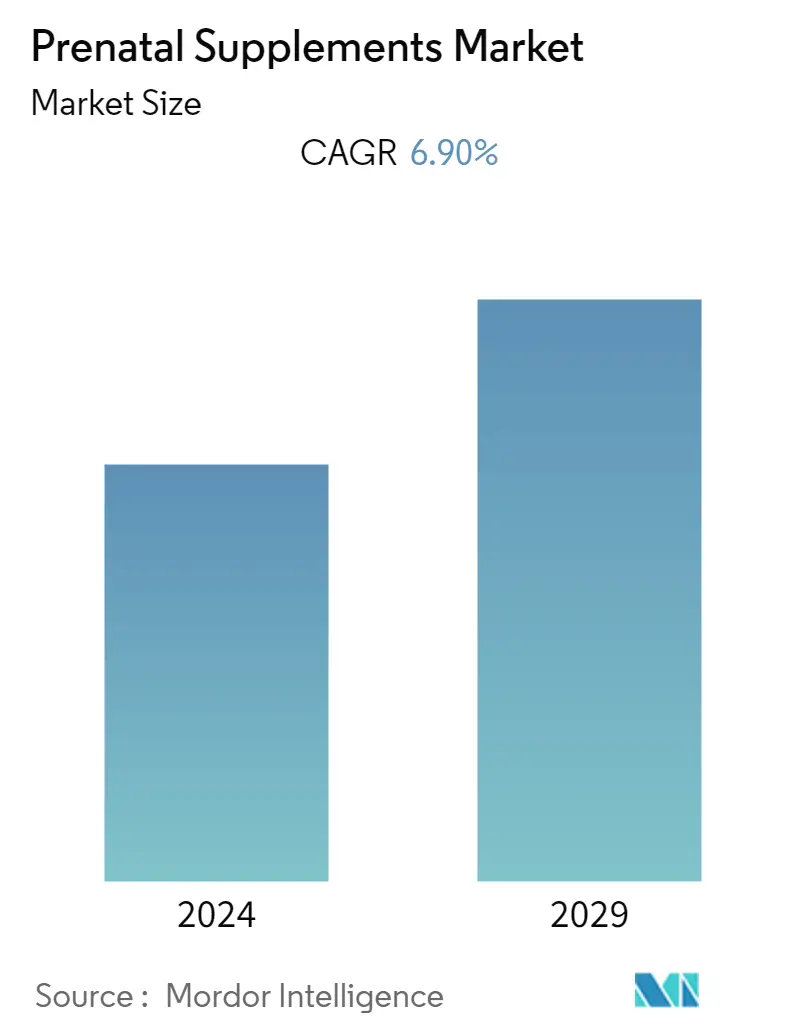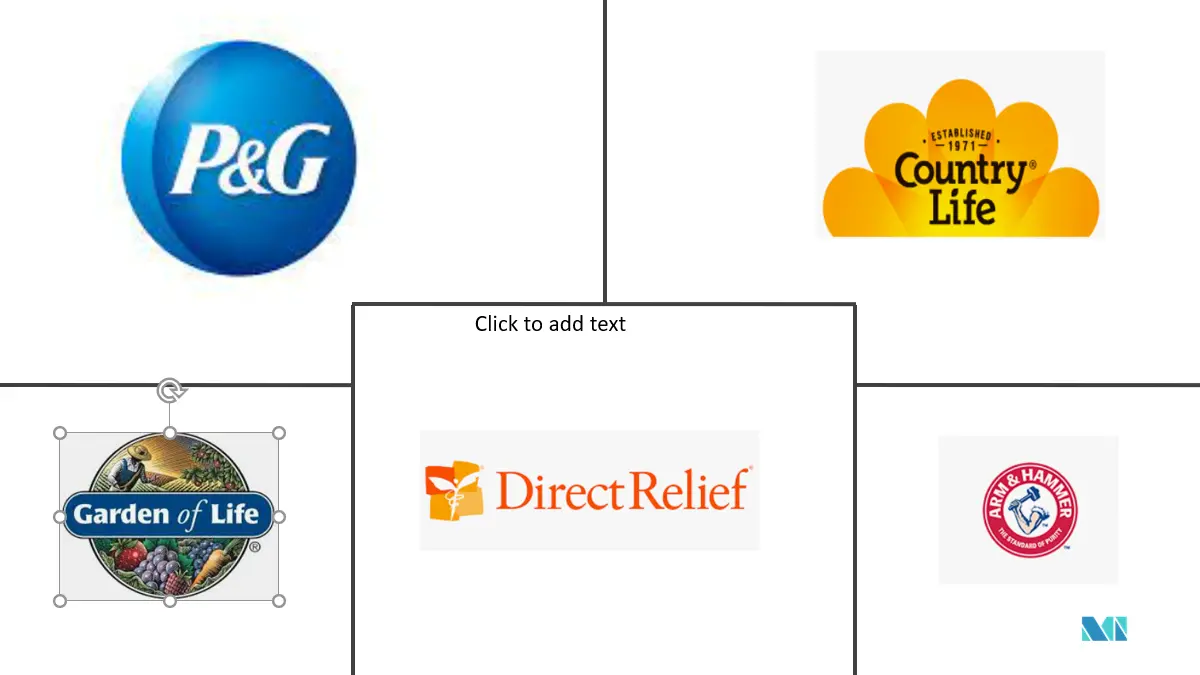Market Size of Prenatal Supplements Industry

| Study Period | 2019 - 2029 |
| Base Year For Estimation | 2023 |
| CAGR | 6.90 % |
| Fastest Growing Market | Europe |
| Largest Market | North America |
| Market Concentration | Low |
Major Players
*Disclaimer: Major Players sorted in no particular order |
Prenatal Supplements Market Analysis
The prenatal supplements market is projected to register a CAGR of 6.9% during the forecast period (2022 - 2027).
The COVID-19 situation affected globally. In addition, food prices crept up across the world during lockdown due to disrupted supply chains. Prenatal supplements are essential for the health of pregnant women, responsible for various reasons like immunity, child's growth, etc. This resulted in the increased demand, resulted in the increased revenue of leading market players, and hence, a positive market impact. According to a United Nations poll, during lockdowns, the number of pregnancies surged in numerous countries, including India (up to 7 million), China (13.5 million), Nigeria (6.4 million), Pakistan (5 million), and Indonesia (4 million). Women were advised to take safeguards such as prenatal supplements in such a vital scenario. As a result, the market for prenatal supplements has grown in popularity.
The prenatal supplements market has been growing owing to the rising health awareness among pregnant women to reduce the risk of necessary nutrient deficiency. Also, in some cases. Government initiatives to create awareness regarding the importance of prenatal supplements among women from underdeveloped countries.
For instance, a study by the UC Davis MIND Institute had claimed that the women who were observed not taking daily prenatal immediately before and during the first month of pregnancy were likely to have a child with an autism spectrum disorder, which is twice the rate as that of women who consumed the supplements. Also, NGOs, such as Direct Relief, which provide prenatal supplements free of charge with a mission to improve the health and lives of people affected by micronutrient deficiencies due to inadequate dietary intake of vitamins and minerals, have further boosted the market growth.
Prenatal Supplements Industry Segmentation
Prenatal supplements are vitamin and mineral supplements intended to be taken before and during pregnancy and during postanal lactation. Although not intended to replace a healthy diet, prenatal vitamins provide women of childbearing age with nutrients recognized by the various health organizations
The prenatal supplements market is segmented by type (vitamins, minerals, essential fatty acids, and other types), form (capsule, tablet, and gummy), distribution channel (supermarkets/hypermarkets, pharmacies and drugstore, direct selling, online retail, and other distribution channels), and geography (North America, Europe, Asia-Pacific, South America, and Middle-East and Africa). The report offers market size and forecasts for the prenatal supplement market in value (USD million) for all the above segments.
| By Type | |
| Vitamins | |
| Minerals (Calcium, Iron, and Other Minerals) | |
| Essential Fatty Acids | |
| Other Types |
| By Form | |
| Capsules | |
| Powder | |
| Gummy |
| By Distribution Channel | |
| Supermarkets/Hypermarkets | |
| Pharmacies and Drug Stores | |
| Direct Selling | |
| Online Channels | |
| Other Distribution Channels |
| By Geography | |||||||||
| |||||||||
| |||||||||
| |||||||||
| |||||||||
|
Prenatal Supplements Market Size Summary
The prenatal supplements market is experiencing significant growth, driven by increased health awareness among pregnant women and the essential role these supplements play in ensuring maternal and fetal health. The demand for prenatal supplements surged during the COVID-19 pandemic, as lockdowns led to a rise in pregnancies and heightened awareness of the importance of nutrition during pregnancy. This trend has been further supported by government initiatives and NGOs promoting the use of prenatal supplements, particularly in underdeveloped regions. The market is characterized by a strong emphasis on the health benefits of these supplements, including their role in reducing the risk of autism spectrum disorders and other developmental issues, which has led to widespread recommendations by healthcare professionals.
North America dominates the prenatal supplements market, supported by a shift in parental demographics and the adoption of advanced healthcare technologies. The region's market growth is bolstered by the increasing availability of prenatal supplements and the rise of e-commerce platforms, which have made these products more accessible to consumers. The market is moderately fragmented, with key players like Country Life LLC, Direct Relief, and Procter & Gamble Company actively engaging in strategic partnerships and product innovations to expand their market presence. These companies are focusing on enhancing their product offerings and leveraging online retail growth to capture a larger share of the market.
Prenatal Supplements Market Size - Table of Contents
-
1. MARKET DYNAMICS
-
1.1 Market Drivers
-
1.2 Market Restraints
-
1.3 Porter's Five Forces Analysis
-
1.3.1 Threat of New Entrants
-
1.3.2 Bargaining Power of Buyers/Consumers
-
1.3.3 Bargaining Power of Suppliers
-
1.3.4 Threat of Substitute Products
-
1.3.5 Intensity of Competitive Rivalry
-
-
-
2. MARKET SEGMENTATION
-
2.1 By Type
-
2.1.1 Vitamins
-
2.1.2 Minerals (Calcium, Iron, and Other Minerals)
-
2.1.3 Essential Fatty Acids
-
2.1.4 Other Types
-
-
2.2 By Form
-
2.2.1 Capsules
-
2.2.2 Powder
-
2.2.3 Gummy
-
-
2.3 By Distribution Channel
-
2.3.1 Supermarkets/Hypermarkets
-
2.3.2 Pharmacies and Drug Stores
-
2.3.3 Direct Selling
-
2.3.4 Online Channels
-
2.3.5 Other Distribution Channels
-
-
2.4 By Geography
-
2.4.1 North America
-
2.4.1.1 United States
-
2.4.1.2 Canada
-
2.4.1.3 Mexico
-
2.4.1.4 Rest of North America
-
-
2.4.2 Europe
-
2.4.2.1 Spain
-
2.4.2.2 United Kingdom
-
2.4.2.3 Germany
-
2.4.2.4 France
-
2.4.2.5 Italy
-
2.4.2.6 Russia
-
2.4.2.7 Rest of Europe
-
-
2.4.3 Asia-Pacific
-
2.4.3.1 China
-
2.4.3.2 Japan
-
2.4.3.3 India
-
2.4.3.4 Australia
-
2.4.3.5 Rest of Asia-Pacific
-
-
2.4.4 South America
-
2.4.4.1 Brazil
-
2.4.4.2 Argentina
-
2.4.4.3 Rest of South America
-
-
2.4.5 Middle-East and Africa
-
2.4.5.1 South Africa
-
2.4.5.2 Saudi Arabia
-
2.4.5.3 Rest of Middle-East and Africa
-
-
-
Prenatal Supplements Market Size FAQs
What is the current Prenatal Supplements Market size?
The Prenatal Supplements Market is projected to register a CAGR of 6.90% during the forecast period (2024-2029)
Who are the key players in Prenatal Supplements Market?
Country Life, LLC, Church & Dwight Co. Inc., Direct Relief, Garden of Life and Procter & Gamble Company (New Chapter) are the major companies operating in the Prenatal Supplements Market.

